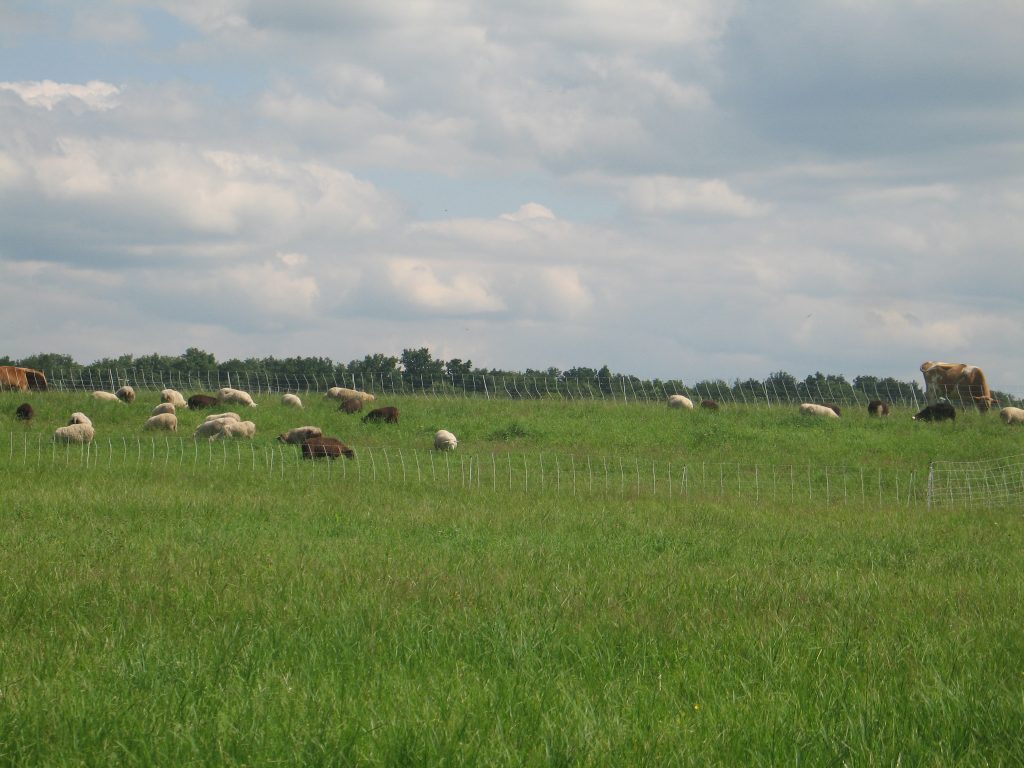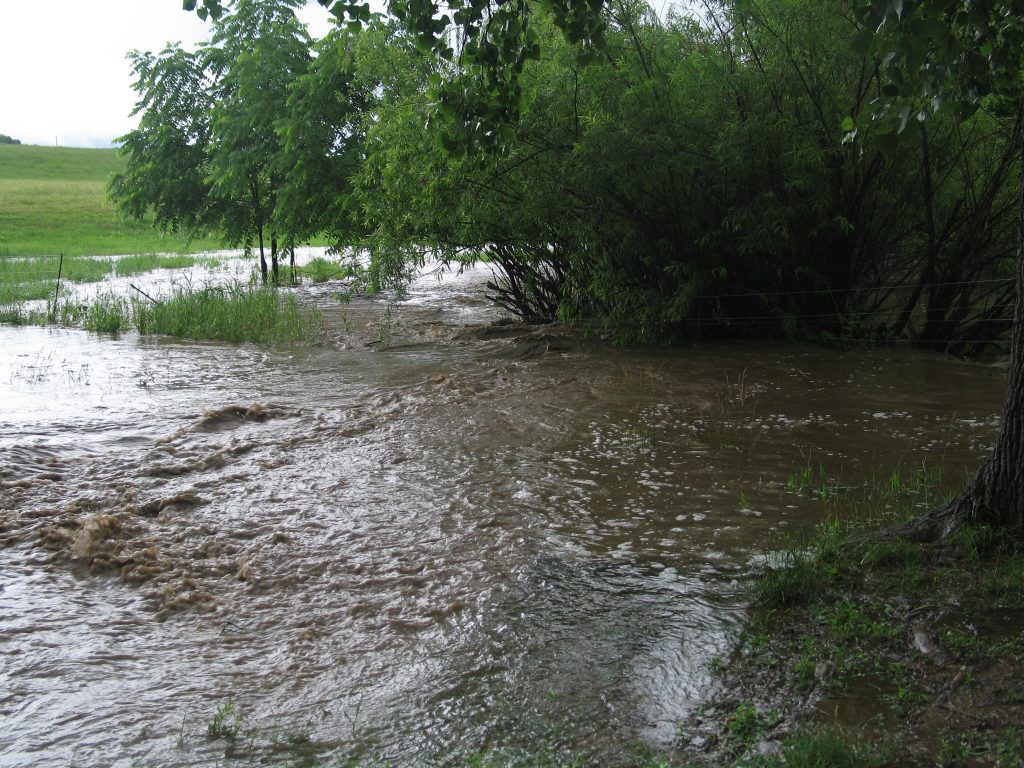It has been a while since I posted an update, and that is not because I forgot to! June and July have been interesting and very busy.
Clementine had a beautiful bull calf on May 25th, and has become a good milk cow. She is a great mother, and we experimented with leaving the calf on for a while. After a month, he was extremely difficult to catch, but looked fantastic since he was drinking most of her milk! We separated them, and he had to learn to be tied and how to drink from an artificial nipple instead of his mom. Now that he associates us with food he is catchable, and we can use him to ease milking duty when necessary! We recently put him back on his mom for a couple days so we could take a quick trip. His help was invaluable, since it is hard to find a person able and willing to fill in for milking!

We planted a good-sized vegetable garden this spring, which is very exciting, as we have missed having our own vegetables the past 3 years we have not been able to do a garden. The vegetables are starting to come, and they are wonderful! Homegrown new potatoes, cucumbers, garlic, onions, kohlrabi, zucchini, and herbs have been our harvest so far. We have been relishing them!

June was dry and our area was considered to be in a mild drought. We have been implementing intensive rotational grazing this year to improve both pasture and animal health, and have been mowing paddocks after grazing, spreading fertilizer, moving the temporary net fences daily(and thus moving watering systems daily, and those really could use some improvements in efficiency)! We learned that lime application is crucial for quality forage in our area since it allows the grass and legumes to access the nutrients already in the soil. Raising the pH also is supposed to suppress the weeds, of which we have far too many. We discovered that the green grass-like plant covering our fields that the animals don’t eat is nut sedge, which is a persistent weed with no feed value.



Uh-oh! Someone’s on the wrong side of the fence!
Since the beginning of July we have been getting copious amounts of rain. The first week we got a storm that dropped 2 inches of rain in about 3 hours. Our soil was dry and unprepared, so more ran off than soaked in. The creek flooded more than we had seen, and it was helpful for us to observe the ‘flood plain’. Thankfully no animals were pastured near the creek that day and the only damage was that a fence energizer was submerged. Thankfully, the energizer was able to be cleaned up and continues to function! After that storm, we continued to get daily small amounts of rain until last week when we received another 2.5 inches of rain in a morning. The creek once again flooded, dismantling some net fences we had across it. No animals were harmed, although half the ewes were out for some time. A few days later we got another 2 inches of rain! That rain took all day to fall, and the creek did not get as high as the other two times, though we were fully prepared for a higher flood this time! The soil is very wet now, and mud is everywhere, but our pastures are growing! The excessive moisture brings its own set of issues, but we are thankful that we are no longer in a drought.

Flooded creek crossing 
Almost normal creek crossing with the Geo Tracker for scale.
This summer has brought a few educational experiences in regards to medical care of the sheep and cows.
When Clementine calved, the rubbing of her new udder on the insides of her legs caused large sores to develop. The poor cow was very uncomfortable, and I tried a variety of treatments on the side that just didn’t want to heal. It even oozed fluids down her leg to where the flies could get to it, and they caused a new, nastier sore to form lower down! She was very cooperative, allowing me to lift her hind leg up and out so I could reach in between her upper leg and her udder to clean and apply salve. I kept applying BluKote to the lower sore to help dry the oozing and try to keep the flies at bay, and eventually she healed up. I don’t know if there is a reason she developed such sores while our other first-calf heifer did not, but now we know to keep an eye out for such complications!
Daisy, one of our yearling heifers, gashed her side on something in the paddock. We discovered the injury in the evening, so after-hours for our vet. We weren’t sure if stitches were necessary, or if we could care for it ourselves and an emergency call would be a waste of money and our vet’s time. Dan called his sister, who happens to be a large animal vet in another state, and she gave us some instructions for care, and reassurance of the healing capabilities of cows. We flushed it with betadine, and gave her a shot of penicillin. Now she is scared of me, but with daily penicillin and betadine, we hope to stave off infection so her body can heal despite the best efforts of flies and bacteria.
In the midst of our rainy July I noticed one of our ewes off by herself while the others were busily eating(a sure sign of an issue!) I grabbed her and took a look at her. She was twitchy and uncomfortable, and as soon as I took hold of her leg I guessed she had a fever by how hot her skin was. Lo and behold, in the wool on her side and back were thousands of maggots! This is called ‘fly strike’, and I did not expect it since I had read it is usually caused by diarrhea in the wool around their tail and she was clean! I promptly sheared the area, and rinsed the maggots off with a saline solution. As soon as the maggots were removed, she relaxed and her temperature came down. They had not caused much damage to her skin, thankfully. I think they may have got started by her having a scratch from a thorn or something similar that attracted the flies to lay eggs in the area. Also, all the warm wet weather apparently that provides perfect conditions for incubating fly larvae! Yuck! Dan and our girls carefully removed every maggot with combs and brushes, and the next day Button(the sheep) was totally back to normal other than looking silly with an incomplete haircut!
We sold our meat rabbits after getting frustrated with the buck having health issues that interfered with his performance. We also would rather invest our time into other aspects of the farm right now. Our oldest child was disappointed, since she enjoyed the bunnies, but in less than a week a customer gave us some pet rabbits that they were tired of caring for and those work much better for our daughter’s desires than the unfriendly meat rabbits.
Bessie, our first Jersey cow, had her third calf on July 19. We had been anticipating her calving for about a week, watching her daily and worrying that something would go wrong. She is a small cow, and her udder became quite gigantic! We also took a quick trip to VT to pick up a new Finnsheep ram lamb a few days before her due date. Thankfully she waited and didn’t calve during the major rainstorm while we were gone! He is a gorgeous brindle Angus cross. She had him secretly, and when I went to the pasture to get the cows for evening chores, there he was, up and bouncing around! This picture is him at 2 days old, Mom checking on him hidden in the long grass. He is super cute and little, and our children are enjoying him!

Altogether, the farm has been operating smoothly this summer and we and our critters are thriving!
